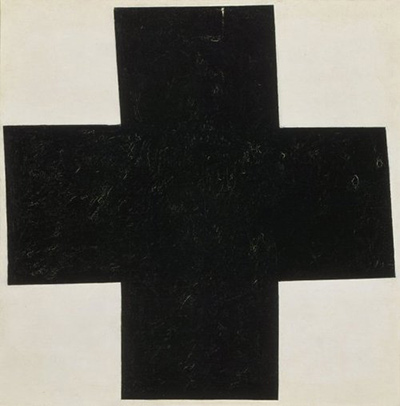Kazimir Malevich's affinity for geometric shapes is seen in his painting, "Black Cross". Like "Black Square" and "Red Square", "Black Cross" uses familiar shapes as the subject of the piece.
Known as the master of geometric abstraction, Malevich experimented with shapes to portray everything from faces to people at work. However, at times, such as with "Cosmic Composition", his focus was solely on the way lines separated areas in space.
With the piece "Dark Cross" Malevich explores an important aspect of human life, that of the power to choose between two options. In some cases, this choice is reduced to one between good and evil. In other situations, it is not so obvious which option is good or will bring results down the road.
Malevich felt the cross was an old image of decision. Despite his yearning to break free of old traditions in art with his system of Suprematism, we still find him reaching for the familiar meanings of symbols in some of his work. The cross here has both religious symbolism in terms of decision making and meaning which applies to cross streets in regular life.
In antiquated circumstances, a cross street is actually the most perilous place you could stand. In this way, the artist demonstrates that decision making is not to be taken lightly. Every time a person has a decision to make, they are in a dangerous place. They have the power to unleash good or disastrous consequences in their life.
Regularly, a cross roads would be the place gatekeepers would get involved to ensure the ruler's property is kept safe. That brings another aspect of decision making into play, since often, decisions are guided by gatekeepers in our lives. These people are usually family and friends who care for us but it does not always mean that their advice is going to produce the result we want. Still, they may help to keep us from making decisions which could bring unwanted results into our property, whether that property is thought of as life or an actual physical asset.
Suprematism is Malevich's legacy. He was extremely keen on Eastern reasoning and utilised it as a base from which to work. He felt he was like the Creator in a way, since he too made things that had never existed. That can be said to be true of all human beings. It is part of the way in which we may be considered to be made in the image of God. We have the power to create new things and use the resources we have been given to solve new problems.
Malevich said that what he made was not subject or subordinate to any of the laws of nature. However, this was wishful thinking in a way, since everything he created was more of an innovation, with its starting point in something that existed before.
He aimed to make work that seemed to have no perspective at times. A viewer can take "Black Cross" and turn it almost any bearing they wish and it sometimes has no effect to their comprehension of the work. That was Malevich's aim.
The work of art does not seem to take after any physical law, it has no up or down on the surface. However, it is held in place by gravity and even the paint that Malevich used followed the laws of nature. Otherwise, it would not remain on the surface and the molecules would not stick to each other. Malevich felt it was precisely the same as the laws of material science in space, or that of the universe.
Malevich composed a statement of sorts that represented his artistic vision. This was, "From Cubism to Suprematism: The New Realism in Painting". This written work established the Suprematist development in 1915. For Malevich, painting must be free of political or social substance, simply tasteful, and concerned just with formal issues of line, shape, and shading.
Announcing his Black Square as the zero of frame in 1915, Malevich flagged a conclusion to pictorial traditions and the starting point of another, pioneer dialect of substance free structures. His work was guided by the movement in reasoning at that time, which also influenced writers of the age. While Suprematism started before the Revolution of 1917, its impact was unavoidable in the early age until the ascent of Social Realism.
In spite of the fact that Malevich in the end came back to representational painting, Suprematism hugely affected the advancement of theoretical workmanship in the both Soviet Union and in Western Europe. Among key specialists of the development were Malevich and artists such as Alexander Rodchenko and Olga Rozanova. Malevich separated the movement of Suprematism into three phases based on hues. The dark stage denoted the beginnings of the development, and the zero degree of painting, as exemplified by "Black Cross".




